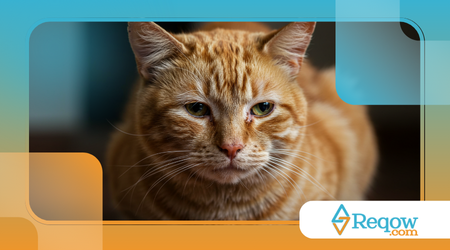Behavioral Signs That Your Cat May Have Kidney Problems (And They Go Unnoticed)

Kidney problems. They don't make noise, they don't send obvious warnings, and in cats, signs that something is wrong often appear too late.
Advertisements
Recently, it's been one of the leading causes of death in domestic felines, and yet many owners only realize something's wrong when symptoms are already severe. That's why understanding the behaviors that indicate this risk is so important.
Kidney problems in cats don't start overnight. They develop slowly, and the first signs are usually subtle—but consistent.
Has your cat been drinking more water? Is he urinating outside the litter box? Is he sleeping more than usual or seems disconnected from his surroundings? These could be early warning signs that something isn't right.
And when you learn to recognize these behaviors early, you greatly increase your chances of treatment and quality of life.
Advertisements
Changes in Urination Habits
Cats are discreet, but their urine can tell important stories. One of the first signs of kidney problems is a change in the frequency or volume of urine.
If you notice that the litter box is wetter than usual, or that he is urinating outside the correct area, pay attention.
It's also common for cats to try to urinate more frequently, but only do so in small amounts. This happens because the kidneys begin to filter the blood poorly, accumulating toxins and disrupting the body's water balance.
If these changes appear gradually, many owners don't even notice — and that's where the danger lies.
Unusual Headquarters
A cat that starts drinking water constantly may be asking for help without words. Polydipsia (increased thirst) is a classic behavior in felines with kidney dysfunction.
As the body tries to eliminate toxins through urine, fluid loss is greater, and the cat feels the need to hydrate more.
A healthy average is about 50 ml of water per kilogram of body weight per day. If your 4 kg cat is emptying its water bowl several times a day, this excess water intake should be taken seriously.
It's one of those behaviors that seems harmless, but reveals the body's effort to balance itself.
Read also: Common Cat Diseases and How to Prevent Them
Loss of Appetite and Progressive Weight Loss
Another silent and dangerous sign is weight loss, even if the cat is still eating something.
When the kidneys fail, the buildup of toxins in the blood affects taste, appetite, and metabolism. Gradually, the individual eats less, rejects foods they once loved, and becomes increasingly thin—for no apparent reason.
This weight loss can be mistaken for pickiness or “fussiness,” but it is a warning sign.
In a survey by the Royal Veterinary College, more than 601,000 cats with kidney disease experienced weight loss in the weeks leading up to diagnosis. The change is slow, but the impact is profound.
Lethargy and Behavior Change
Is your cat less active? Does he sleep more, avoid playing, and seem less interested in the household routine? These behavioral changes may also have a physical cause.
When the kidneys fail, the accumulation of urea in the blood affects the functioning of the nervous system, causing fatigue, confusion and even depression.
It's as if the cat is present, but not connected. It withdraws from humans, stops seeking affection, and often isolates itself.
Sometimes this type of change is interpreted as old age — but it can be a sign of something treatable if caught early.
Bad Breath and Excessive Licking
Has your cat's breath changed? Is it stronger, smelling like ammonia or something metallic? This could be a sign of urea buildup in the blood—a direct consequence of kidney problems.
Along with this, some cats start to lick specific parts of their body with exaggerated frequency, trying to deal with internal discomfort.
It's as if the body is trying to eliminate something toxic from the inside out. The tongue becomes an outlet for the discomfort the cat can't explain.
It may seem like compulsive behavior or anxiety, but it is often linked to kidney failure.
Feline Analogies: When the Litter Box Becomes a Thermometer
Imagine the litter box as your car's dashboard. If anything changes there—frequency, color, volume—it's like a warning light flashing on your feline dashboard.
Cats use urine as an indirect way of showing what's going on inside.
Ignoring these changes is like covering the speedometer while speeding down the highway: you won't realize you've gone over the limit until it's too late.
Two Examples Many Tutors Ignore
A common case is that of a cat that suddenly starts sleeping in unusual and cold places, such as the bathroom floor or inside the shower stall.
This may seem like just "habits," but it's a classic sign of internal discomfort. Another example: that cat who was always sociable and starts avoiding being held. It's not a personality trait—it could be pain or fatigue.
Prevention and Monitoring
The best way to prevent kidney problems is with frequent veterinary check-ups, annual blood and urine tests (or biannual tests in older cats) and adequate nutrition.
Cats that eat dry food must have constant access to fresh water or wet food to keep their kidneys functioning well.
Avoid self-medication and never give anti-inflammatories or painkillers without a prescription. Feline kidneys are extremely sensitive to medications, and a simple incorrect dose can accelerate a process that would otherwise take years to develop.
Conclusion
Kidney problems in cats are a serious condition, but not invisible. It presents signs. The challenge lies in recognizing them while there's still time to act.
Behaviors like drinking a lot of water, urinating more than usual, losing weight, and appearing "disconnected" shouldn't be ignored—they may be your cat's only way of asking for help.
You know your cat better than anyone. If something has changed and seems off, trust your instincts and seek professional advice.
Identifying the problem early makes all the difference in treatment and quality of life. After all, when it comes to feline health, silence can be the greatest cry for help.
Questions About Kidney Problems in Cats
How do I know if my cat has kidney problems even without an exam?
Ideally, this should be confirmed with tests, but signs such as excessive thirst, excessive urination and apathy are important indicators.
Can young cats also get kidney disease?
Yes, although it is more common in older cats, the condition can affect felines of any age.
What to do when you notice symptoms?
Take your cat to the vet as soon as possible. The sooner the diagnosis, the better the chances of stabilizing the condition.
Is there a cure for kidney problems in cats?
Not exactly, but there is control. With proper diet and monitoring, many cats live well for years.
Does wet food help with prevention?
Yes. Wet food increases water intake, reducing the strain on the kidneys.
